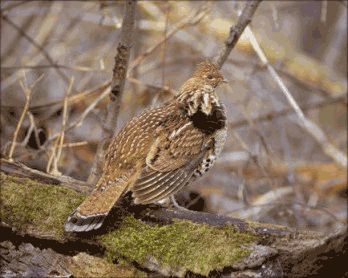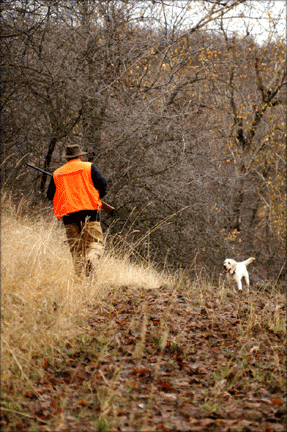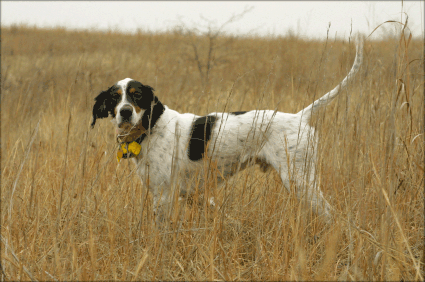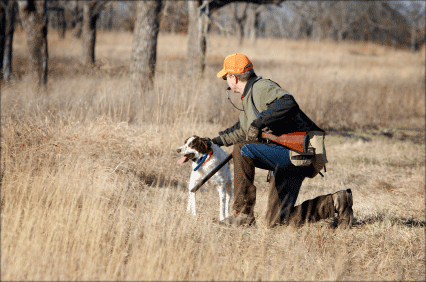Hunting Grouse With the Stealth Approach
The ruffed grouse is to the forest what pheasants are to the grasslands. But unlike the flashier, bigger plains bird, you can’t bully a grouse around. The “we-got-’em-surrounded” mentality that often works with pheasants – big crowds pushing a section of real estate to pinch birds and force them to flight – won’t get you anywhere in the grouse woods. No, this is one bird that requires finesse.
Like a Circus
I used to hunt with four or five gentlemen every year on some private, long-abandoned logging grounds we had access to in the mountains of West Virginia. It was gorgeous grouse habitat: meadows interspersed by ancient apple orchards and hawthorne tree stands, and where the selective logging had occurred, downed, left-over logs were surrounded by myriad berry-bearing shrubbery and young tree regrowth. It had everything and more that a few grouse could want – shelter, food, and relatively little encroachment from humans. The place never failed us. We always shot grouse. But knowing what I know now, we could have done better – a lot better – and so could others I’ve seen hunt as I did with these guys.

Our first problem was that there usually were a half-dozen of us. But it wasn’t just the number of human trespassers to this piece of grouse fairyland that was the problem. We also usually had as many dogs between us, and since every one of us carrying a gun was a weekend warrior with a job in the city, after a long drive and a crappy motel stay, every single one of us had to put our dogs out – at the same time. There simply weren’t enough weekends in the season to go around, so leaving a dog on the truck – “I’m not leaving my dog behind!” – wasn’t even a consideration. The result was a circus.
Now, part of my group’s three-ring problem was due to more than just the confusion brought on by a dozen hunters and dogs running amok. The environment played a role in the confusion as well.
I never hunted those mountains when the wind wasn’t howling, and the weather was often just altogether brutal, with stinging drizzle, sleet, pouring rain, and always freezing temperatures (the place wasn’t too subtly named Mount Storm). To hear over the wind and elements as we pushed the ground, we got loud. “Bird! Bird!” one would bellow, as a grouse was gotten up and fired at, the cadence of shouts and gunfire continuing as the birds maneuvered, often unscathed, between all of us and the trees. Our dogs’ beepers and bells only added to the ruckus. Like I said, it was a circus.
Pair Off
Six of us abreast in the typical pheasant-field-push formation often did not much more than push the birds continually ahead of us. And if you were thinking four pointing dogs and a Lab or three must have balanced that out, well, you’d just be wrong. In all, while we never went home empty-handed, we truly had the wrong approach.
Let me make this clear: grouse hunting is not a group sport. For this many hunters having only a few opportunities to get together at one time, we should have split up. We should have set out in pairs in completely different directions, each pair of humans with no more than a brace of dogs. From a full-limit standpoint, the camaraderie would have been better left for lunch and the end-of-day flask sip.

But even had my group insisted on the throng approach, we had another problem that compromised our ratio of trigger pulls to birds bagged. Remember all that shouting and ringing of dog bells and shrieking of whistles I mentioned? That’s a whole lot of excess noise that any grouse in its right little bird mind will flee the country on. See, with grouse, the trick to gun-ready flushes lies somewhere between silence and sounds that will startle – not in a constant din.
You and a friend (I’ll get to the dogs in a minute), working at a leisurely pace through the woods, kicking through dry leaves, snapping twigs, and keeping conversation minimal, will usually encourage the ruffed grouse to hunker down and hold tight. Evolution has taught them that their wonderful plumage is terrific camouflage, if they will just hold still. Well, up to a point, anyway.
Hold too long, and that fox or bobcat padding through the understory is going to pounce. But you know what that fox or bobcat does before he pounces? He gets quiet. He sits back on his haunches or crouches down on his belly, pausing to make sure the energy he’s about to expend will result in a captured meal. It’s in that moment of stillness that a pinned grouse will often opt to exercise his alternate survival skill, which is he’s going to flush.
Hunt grouse like the predators do. Move steadily, but easily, through the cover, keeping noise to just what your brush pants and canvas coat sleeves make as they pass. Walk for a while, then pause. Stop. Stay quiet for a moment, look around, and be ready to shoot. If a grouse is nearby, there’s an excellent chance he’s going to take flight the second you scratch the leaves with your toe as you begin to step forward again.
This minimalist, this stealth approach, is the way to shoot grouse. You are playing to the birds’ known behavior, instincts that have served them well over centuries. And by proceeding in this manner, you are setting yourself up to be best prepared to take the shot when it presents itself. You’ve looked around, can see where between the trees a flushing ruffie is likely to fly, and now have a much better chance of putting a bacon-wrapped grouse breast in the pan instead of seeing just a few tail feathers drifting to ground.
The added beauty to this method is that you don’t even need a dog. But I don’t know a died-in-the-wool grouse hunter who would set forth without one.
Man’s Best Friend
Grouse hunting is the domain of pointing dogs. Setters, pointers, short-hairs, and Brittanies rule the roost here, though having one of those and a flushing dog like a Lab or a cocker or springer along certainly makes a nice day out, too. Most hunters know the key to successful upland hunting with dogs is good dog training, but, in reality, most amateur handlers rarely know what that fully encompasses. My West Virginia grouse-hunting friends were good examples of this overall lack of gundog knowledge.
In addition to the group approach, ours were hunts that seemed to resemble track events. I don’t know whether these guys had been taught this way or if, over their years pursuing grouse had come to believe it was necessary, but their collective approach was to push as much countryside as they could as fast as they could. Even in years I was in relatively good shape, I often huffed and puffed to keep up with them.

A big part of the reason for this mad rush through the hillsides – and aside from their driving belief that it was miles covered that put birds in the bag – was because none of our dogs were finished dogs. (Mea culpa, I’d have to include mine in that mix.)
For a pointing dog to be truly finished, or fully trained, he needs to hold point until the handler orders otherwise. That means for five seconds or five minutes or five hours, whatever it takes.
A finished pointing dog does not crowd the bird, does not creep on his point, and never flushes the bird. Further, he should remain staunch when the bird flushes and the gun is fired. This is what is commonly known as “steady to wing and shot.” Part of this philosophy is a safety issue. If the dog is steady to wing and shot, you not only know where he is, but he will not be leaping into the pellet string if you fire at a low-flying bird.
Another reason to have a steady dog? Grouse don’t usually fly far after flushing. If you move quietly along the flight path, you can often relocate a once-flushed bird some 30 to, say, 100 yards from where he first rose. But when a dog isn’t steady to the wing or flush, there’s a strong probability he’s going to give chase to the bird once it flushes, and that will keep the bird moving further and further ahead. You’ll never get the chance to reflush and shoot again.
Keep this in consideration, too: if your pointing dog won’t remain steady to the flush, he’s probably full of other bad habits, like creeping and crowding, and probably flushing more birds than you can imagine. So what you have with a pointing dog that isn’t finished is a dog you can’t trust out of your sight.
Back on those West Virginia hunts, we rushed – aw, hell, we flat-out ran – to get to our dogs so we could flush the birds before the dogs took matters into their own paws. It didn’t mean our dogs didn’t point, it didn’t mean that they couldn’t find birds, it was just an issue of them not being completely steady.
Of course, this meant that we kept our dogs at pretty close range, too. Lots of amateur handlers never let their pointing dogs range out of sight for exactly the reason I just discussed: they can’t trust their dogs.

But think: are you really finding more birds with a dog you keep under your thumb? Maybe one or two, but really, if you’re going to hunt with a close-working pointing dog on a bird that holds as well as the ruffed grouse, you’d probably kick up just as many without him. The “point” of a pointing dog is to find birds you the hunter are not finding. And for that to happen, you need to let him range. The more ground he’s covering, the more birds he’s finding. It doesn’t mean you don’t want him to close it down a bit in really thick cover, but repeat after me: It is okay to let my pointing dog range out of my sight.
I know, I can hear it already. You’re wondering: how will I know where the dog is if I can’t see him? There are two solutions to this, the electric beeper collar or, my favorite, the traditional cow bell. (And no, I don’t think the sounds of bells or beeper collars flush grouse. Pheasants maybe, sometimes, but not grouse.)
I use a beeper collar often when bird hunting most upland species, especially in more open habitat, because I can hear it from further away and often over high winds. I always use one that functions in both a running mode and a pointing mode so I can tell, generally, what the dog’s doing. But I actually like the bell better for grouse hunting. Here’s why…
The bell is exacting where the beeper collar is generalized. With the beeper, I only know the dog is moving or standing still. And if he’s out of sight, I don’t know if the standing-still beep means he’s on point, taking a drink of water, or peeing on a tree. With the bell, I know all of these things and much, much more, just by the way it rings.
A steady clang? I know he’s working the cover methodically and thoroughly. When the clattering gets a little spastic, I know he’s hot on scent. And just a tiny “tick, tick, tick?” That’s the clanger echoing his breathing, when he’s solid on point – and I can hear this even when I can’t see him, which allows me to get ready to shoot when I do spy him and walk up on the point.
Also, I hear the difference between a dog that’s begun to creep on his point and one that takes a step to balance his body. I also can tell if he’s lost control and charges the flush –
and it doesn’t take a practiced ear to figure this out.
I really like to use a bell in conjunction with an electric collar (on an e-collar-trained dog, of course), because you can make corrections to the dog without having him in your sight. The bell tells you, is he creeping? Give him a little nick to put him back on hold. Hear him charge a flush after being silent on point? Give a jolt to pull him off the pursuit. (All of this, of course, assuming your dog is at least mostly trained and understands this type of correction. You wouldn’t want to do this to a young dog just beginning and turn him off birds, but that’s a subject for a whole separate article.)
The point of the bell is that I can let the dog do the work of finding birds instead of me hiking all over hell and half of Georgia. I take the dog off the truck, set him loose, listen for the bell, and walk toward it, either leisurely in the general direction if the dog is working steadily, or directly toward the last place I heard it ringing if it stops. I work less, while the dog finds more birds. Two birds in the hand….
So remember, when it comes to ruffed grouse, a careful, thoughtful, and methodical approach is what brings success with this forest dweller.
Jennifer L.S. Pearsall is a professional outdoor writer, photographer, and editor, who has been a part of the hunting and shooting industries for nearly 20 years. She is an avid clays shooter, hunter and dog trainer. Please visit her blog “Hunting the Truth” at http://huntingthetruth.com.
{loadposition signup}


Comments